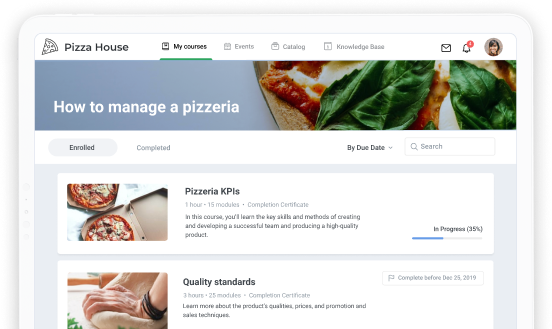Best Online Learning Platforms – Starting Off on the Right Foot

Since the technology revolution of the late 1990s, online learning has been gaining popularity as a method for training and instruction. It offers unparalleled convenience, flexibility, and affordability in a world that’s becoming increasingly expensive and busy.
And everyone’s jumping on the bandwagon now, especially with no end in sight to COVID. With this demand, online learning platforms have become one of the most coveted products on the global market. But choosing the right platform is no small feat! There are infinite options, each with its own set of unique features.
That’s why, whether you’re a business hoping to train employees, or you work in the academic sector, we’ve got you covered! Keep reading to find out what the best online learning platforms are. In this article, you’ll find a detailed description of each platform, its pros and cons, pricing, why we included it on our list, and who it is the best fit for.
- Udemy Business
- Skillshare
- LinkedIn Learning
- Coursera
- edX
- iSpring Market
- Kajabi
- Podia
- iSpring Learn
- SAP Litmos
- LearnUpon
- Blackboard Learn
- Canvas
- Moodle
What Is an Online Learning Platform?
An online learning platform is a digital space that allows course creators to market, sell, and deliver their eLearning courses. They’re often referred to as “online course marketplaces.” Like traditional schools, such platforms offer learners a safe environment in which to learn, access course materials, and, in many cases, interact with both teachers and students alike. They offer a wide range of features, including, but not limited to lectures, assignments, quizzes, learning interactions, completion certificates, and social forums/chats.
So, in a way, “learning platform” is kind of a catchall term for both businesses and learners. They help you create, catalog, market, and accept payment for your courses, while also providing all the tools and educational resources that learners need under one roof.
Online Learning Platforms vs. Online Course Platforms vs. LMSs
It’s easy to conflate online learning platforms with online course platforms and LMSs. But it’s worth making the distinction. Let’s start with online learning platforms.
As mentioned, an online learning platform is more of a marketplace. It focuses on the perspective of learners or “buyers.” That’s because online learning platforms do much of the heavy lifting when it comes to marketing your courses, growing your audience, and building your sales funnel. So here, the priority is the front-end part of your business – the course marketplace, as well as the courses themselves.
However, this heavy lifting comes at a cost. For example, if you’re looking for maximum flexibility with pricing structure and functionality in terms of collecting and analyzing user data, then you’re going to be relatively constrained. That is especially so if you’d like to personalize your online courses with adequate branding.
In contrast, online course platforms focus more on the back-end portion of things. They often involve instructor-focused, cloud-based software that enables you to not only create courses, but effective learning environments. For example, you can upload various types of learning materials and arrange them into learning paths.
Many course platforms also let you set up your own marketplace – that is, your own sales funnels, pricing plans, memberships, and revenue. Not to mention that you gain control over invaluable user analytics, branding, and marketing strategies to maximize the growth of your business.
As for learning management systems (LMSs), they’re less focused on sales and marketing and more focused on seamlessly delivering training to large groups of learners, employees, or partners, for example.
Compared with online educational learning platforms, many LMSs have built-in course authoring capabilities, enabling you to create new online courses. Besides, LMSs allow you to manage users, assign content to them, and track learner progress – all under one roof.
All in all, you can think of LMSs as representing a higher tier of course platforms. They offer you extra freedom and flexibility in terms of the types of courses you can create and the level of interaction you can incorporate.
Understanding the difference between online learning platforms, online course platforms, and LMSs will help you narrow down options within the vast sea of eLearning products. But even once you’ve settled on a specific platform type, there are still many choices to sift through. Continue reading to find out what they are.
How We Tested Online Learning Platforms, Course Platforms, and LMSs
To create this in-depth review of online learning platforms, we test-drove all the solutions that provide free trials. We explored their functionality and compared their capabilities, assessed the user interface, whether the platform is easy to use, and evaluated how closely each feature meets the needs of its target audience.
We also studied documentation carefully and watched demo videos of those platforms that don’t offer a free trial.
Best Online Learning Platforms for Businesses
| Platform | Who is it for? | Pricing |
| Udemy Business | L&D professionals or business owners who don’t have the time or budget to create their own online courses | Team (5-20 users): $360 per user/year Enterprise (21+ users): need to contact sales for a custom quote |
| Skillshare | Design and visual arts professionals | Starter (2-19 users): $159 per user/year Enterprise (20+ users): via request sales for a custom quote Revive (51+ users): via request sales for a custom quote |
| LinkedIn Learning | Individuals or businesses looking to upskill their teams in business, the tech industries, and the creative arts | Annual: $26.99/month Monthly: $39.99/month |
1. Udemy Business

If you’ve ever dipped your toes in the eLearning waters, then you’ve definitely encountered big fish like Udemy or Udemy Business. Udemy Business offers 14000+ courses for over 9500+ companies on a wide range of topics.
As a learning platform for business, its specialty is skills-based training courses. Expert instructors can easily upload their video-based courses (e.g., screencasts, talking head videos, and video presentations) and track trainee progress, analyze data, and glean actionable insights. However, regrettably, the content has to be created outside of the platform; there are no built-in course creation functions.
Pretty much anyone can become an instructor on Udemy. Though many are specialists and/or highly passionate about a specific topic, this also opens the door to quality control issues. In any case, Udemy Business is a solid choice if you, as an instructor, are looking to reach a large audience. Its wide user base makes it easier to market and monetize your courses. And as a training manager/business, it’s a hands-off way to bring your team’s skills up to speed.
Pros
- Easy to use
- Quality control measures
- Completion certificates
- Integrates with LMSs
Cons
- No course creation functions
- Only supports video-based courses
- Passive learning (i.e., lack of interactivity)
- Certificates not recognized by employers
Who is it for?
Udemy Business is the best online learning platform for L&D professionals or business owners who don’t have the time or budget to create their own courses. The affordability of Udemy, coupled with its wide range of skills-based courses, means there’s relevant training content for almost anyone.
However, if your training team is learning highly specific skills that are unique to your business, there’s no guarantee that the courses will provide a one-to-one fit. Overall, it’s a top online learning platform for business teams seeking more general skills.
Why we picked it
Udemy is one of the largest online educational platforms. It describes itself as “The leading global marketplace for learning and instruction.” And since it offers over 213,000 courses and has more than 59 million learners, we think that’s a pretty fair assessment.
Pricing
Udemy Business offers two pricing plans:
- Team (5-20 users): $360 per user/year
- Enterprise (21+ users): Contact sales for a custom quote.
Offers a 7-day free trial.
2. Skillshare

Like Udemy, Skillshare is another big name in the world of online learning platforms. Offering 35,000+ courses for over 5 million learners, they specialize in courses for creative professionals (e.g., graphic design, animation, photography, videography, etc.). So, its learner base mainly consists of individuals, entrepreneurs, and small businesses.
Another feature that makes it distinct is its emphasis on collaboration and social learning. Not only can learners post their assignments on the platform, but other students can engage with them by liking, providing feedback, and asking questions about each other’s work. This makes it easier to get inspired and bring creative skills to the next level.
If you’re looking to join Skillshare’s 8000+ community of instructors, this platform takes it up a notch by providing updated resources and teaching tools for your course topic.
Pros
- Engaged social community of learners
- Large pool of courses
- Engagement and analytics reports
- Multiple marketing integrations
Cons
- Only supports video-based courses
- No LMS integration
- Doesn’t offer certificates
- Quality control is challenging, since anyone can be an instructor
Who is it for?
If you’re a business that works with design or a visually creative workforce, then Skillshare is a great way for them to hone their skills. You’ll have access to a vast array of relevant courses. As one of the few online learning platforms that let users share their work and engage with fellow students and teachers, it’s also a great way to seek inspiration through connection.
To teach on the platform, one needs to be an expert in the creative industry, including business related topics like marketing, business analytics, leadership, and management.
Why we picked it
What we like most about Skillshare is that it is a community-centered platform. Unlike other platforms, learners are able to interact with each other, making this feel more like an interactive class than a video that you’re watching by yourself.
Pricing
Skillshare has a 3-tiered pricing plan:
- Starter (2-19 users): $159 per user/year
- Enterprise (20+ users): Contact sales for a custom quote.
- Revive (51+ users): Contact sales for a custom quote.
Offers a 1-month free trial.
3. LinkedIn Learning

When Lynda.com merged with LinkedIn in 2017, it gave rise to LinkedIn Learning. Specializing in creative, business, and technology courses, it offers 16,000+ courses for a user base of over 700 million people. It’s considered one of the best online learning platforms because the instructors are carefully vetted to ensure that they’re not only subject matter experts (SMEs), but have excellent teaching/presentation skills. As such, its quality control and product quality are top-notch.
The platform offers an impressive degree of interactivity via quizzes and practice exercise files, which can be completed concurrently with their microlearning videos. Once you complete the course, it issues a certificate that you can share proudly on your LinkedIn profile. Though they’re not accredited, it bolsters your profile and can be a real game changer when it comes to business opportunities. In a nutshell, this online education platform offers very high-quality educational content.
Pros
- Instructors that make presentations in LinkedIn video tutorials are vetted
- Appeals to different learning styles (e.g., rather than videos, there’s an option for scrolling transcripts)
- Increased interactivity with hands-on practice exercises and quizzes
- Completion certificates that can be shared on your LinkedIn profile
Cons
- Cannot interact with teachers or fellow learners
- Limited course topics (e.g., only business, tech, and visually creative)
- No LMS, marketing, or analytics integrations
- Completion certificates aren’t accredited
Who is it for?
Individuals or businesses that are looking to upskill their teams in the business, tech, and creative industries will love this platform. Since it allows microlearning courses, they offer maximum freedom and flexibility. This makes it an ideal online learning platform for businesses that train employees off-site, or individuals/entrepreneurs who lead busy lifestyles and need self-paced learning.
Why we picked it
We appreciate the microlearning format that the platform adopts and the high degree of interactivity it offers. But the best thing is that instructors have to prove that they represent an SME and possess top presentation skills. With this platform, simply being passionate isn’t enough.
Pricing
LinkedIn Learning offers a monthly and annual plan as an all-access pass for individuals.
- Annual: $26.99/month
- Monthly: $39.99/month
If you’re interested in pricing for teams, you’ll need to contact them for a custom quote.
Offers a 1-month free trial.
Best Online Educational Learning Platforms
4. Coursera

In a vein similar to that of BitDegree, Coursera is more of an online learning platform for schools, since it offers a vast variety of online degrees, specializations, and certificates – many of which are accredited by some of the world’s most prestigious academic institutions. With 5,000+ courses, 200+ affiliated businesses and universities, and over 77 million learners on the platform, Coursera is a force to be reckoned with.
The majority of their online courses are heavily focused on business-related topics, and especially the sciences (e.g., computer science, data science, health sciences, physical sciences).
Until recently, all the instructors had to be world-class teachers or professors at one of Coursera’s partner institutions, guaranteeing high-quality content from subject matter experts. But they’re less stringent nowadays. In any case, if you want to sell courses on Coursera, you’ll need to know your stuff!
Pros
- Well-structured, high-quality courses from reputed institutions
- Transcripts accompany videos to cater to different learning styles
- Completion certificates that are recognized by many employers/institutions
- Financial aid for low-income learners and/or learners from developing nations
- Follows a classic academic style of learning
Cons
- Limited range of topics (mainly business and science)
- Some courses have start and end dates, meaning you might miss out
- Large body of learners means instructors often don’t respond to your questions or provide feedback
- For assignments requiring peer reviews, particularly in the less popular courses, this could take a long time, which means you’ll have to wait longer for your certificate of completion while continuously paying for your monthly subscription
Who is it for?
Coursera is used by students who are looking for a first-rate education on a learning platform that offers recognized completion certificates and university diplomas. It’s also used by 100+ Fortune 500 companies, 6,000+ college/university campuses, as well as many government institutions.
As for those looking to make money teaching, the best bet is to be affiliated with an accredited institution or thought-leading business. That said, the door’s still open if you don’t fit into those categories.
Why we picked it
We consider Coursera to be one of the most prestigious educational platforms. It partners with world-class universities and organizations to create learning programs, so all the courses are taught by top experts in their field.
Pricing
Coursera offers a 3-tier pricing plan:
- Single learning program (for a single course): $49-$79/month
- Coursera Plus Annual (access to all courses): $59/month
- Coursera Plus Monthly (access to all courses): $399/year
Offers a 7-day free trial.
5. edX

If you’re interested in formal education, then edX is the way to go. It is a mission-driven, massive open online course (MOOC) provider that partners with the world’s top universities and organizations to offer high-quality online courses to learners around the world, including Harvard, Berkeley, and IBM.
As with a university, you can find almost any course topic – be it architecture, art and the humanities, the sciences, linguistics, medicine, business, or economics. edX offers 3,000+ courses (including free courses) arranged into 300 programs. So, while it covers a wide breadth of topics, its course count is relatively low compared to the other online platforms that we covered. However, it offers an impressive degree of interactivity with graded assignments and verified accredited certificates.
If you’d like to be an instructor but aren’t affiliated with one of their 160+ partner institutions, then, just as with a regular university, you won’t be able to create or sell courses on the platform. It’s mainly for course takers versus course creators… just like a regular university.
Pros
- Offers accredited, highly recognized completion certificates
- Offers courses from prestigious organizations like Harvard and MIT
- Most courses can be completed at your own pace
- Wide variety of course topics and learning programs to choose from
- Partially free online learning platform that lets you audit courses
- Low-income learners can apply for financial aid
Cons
- Because partners can create courses as they see fit, there’s a lack of uniformity in course structuring
- Relatively lower course count (3,000+) compared to other platforms
- Somewhat clunky interface
Who is it for?
Because edX mimics the approaches of formal education, it’s more geared toward university and college students who’d like to get a top-quality education with more freedom and flexibility. And because the learning topics are more academic than professional in nature, it mainly attracts learners who are seeking recognized accreditation in order to land jobs.
As such, if you’re a business or training team that needs an online learning platform with multiple-license deals, then check out edX for Business. This platform works in a similar fashion. It offers thousands of courses arranged in a learning path to best train your employees. And the course content is just as world class.
Why we picked it
Like Coursera, edX is a credible platform for education and learning. Its courses are created and taught by some of the top-ranked universities and industry-leading companies in the world, so the quality speaks for itself. What we also like is that after successfully completing a course or program, a learner receives a verified certificate.
Pricing
- edX: While edX offers free courses, the “Verified Track” route (with paid courses) can range from $50 to $300, depending on the course(s) you enroll in. If you’re pursuing a master’s degree, which has more courses, this number can jump as high as $10,000–$25,000.
- edX for Business: For groups (small teams/businesses): $349 per learner/year; Enterprise (large organizations): Contact sales for a custom quote.
Best Online Course Platforms
6. iSpring Market

If you’re looking for an all-in-one learning platform for creating, marketing, selling, and hosting your online courses, then iSpring Market’s got you covered. It is extremely easy to use, but it yields visually appealing, professional, and interactive courses within a highly converting marketplace. It’s a great option if your goal is to get your courses to market as quickly as possible.
iSpring Market is a top online learning platform because it allows you to create and upload learning content in practically any format – audio, video, PowerPoint presentations, and SCORM packages – from robust eLearning authoring tools. So, one thing that really stands out with this platform is that you’re not just beholden to the passive learning styles of the many online platforms that support only video content. Rather, courses that you host on iSpring Market can have interactive, automatically graded quizzes, drag-and-drop and dropdown interactions, and even role-play simulations with branched scenarios.
And the best part is that it provides powerful analytics, providing insight into both trainee progress and your sales performance.
Pros
- Maximum flexibility with course content types
- Hosts courses with sophisticated interactions
- Gamified learning environment with points, badges, and leaderboards
- Incentivizes sales with limited time offers and coupons
- Issues completion certificates
- Ultimate flexibility with payment methods and currencies
- Detailed analytics for tracking learner engagement and progress
Cons
- Basic marketing options
- Basic admin options
- Completion certificates are unaccredited
Who is it for?
iSpring Market is a top online learning platform for course creators who would like to develop a wide range of online courses without being restricted to content type and low levels of interactivity. Despite its ease of use, it has a very rich feature set, both of which are necessary for content creators who’d like to get their courses to market and start making money as quickly as possible.
Why we picked it
iSpring Market is one of the few course platforms that supports SCORM. It allows instructors to host highly interactive immersive content, thus providing learners with a truly engaging learning experience. Besides, it can boast powerful user and content management capabilities and a robust reporting engine. In a nutshell, iSpring Market is a nice mix of LMS and marketplace.
Pricing
iSpring Market offers 4 pricing plans:
- 500 users (25 GB): $77/month
- 1,000 users (50 GB): $147/month
- 2,000 users (100 GB): $277/month
- Custom: Contact sales for a custom quote.
Offers a 14-day free trial.
7. Kajabi

Kajabi is not as dedicated to course creation as it is to selling online courses. Therefore, as an online learning platform, its sales and marketing features are far more robust than its course development tools. For instance, Kajabi’s sales page templates let you create great looking storefronts that help achieve high conversion rates.
As for the course development tools it provides, you can upload video lectures and supplementary materials like worksheets and assessments to accompany each lesson. Moreover, it helps you create impressive learning paths with automated features. For instance, when a learner completes a series of lessons within a module, you can automate it to unlock the next series of lessons under predefined conditions.
But their most distinguishing feature is their “sales pipelines” (also called sales funnels). These guide users through the purchasing process, enabling you to track multiple buyers in an organized, visual, and strategic manner. The fact that you can build your own pipelines maximizes your control over every aspect of the sales process. For example, you can set up automated emails at the opt-in phase and zoom in on each stage of the pipeline to get insightful analytics.
Pros
- Well-designed user interface and user experience
- One-stop-shop solution from course development to sales
- Highly customizable from a branding and marketing perspective
- Great video streaming abilities
- Beautiful, professionally designed landing pages
Cons
- Lacks interactivity and student engagement features
- Doesn’t issue completion certificates
- Steep learning curve, especially during initial setup stages
- Pricier than most other top online learning platforms
Who is it for?
Given its relatively steep learning curve, Kajabi is certainly not for the technologically challenged. You need to be a solid Kajabi specialist to use it effectively. If you’re willing to put in the time and would like to create and sell relatively simple text and/or video-based courses, then the platform might be right for you.
Many entrepreneurs and individuals pay a higher price for Kajabi since they expect to leverage its comprehensive sales and marketing features to turn a profit. It’s ideal for entrepreneurs and businesses who are keen to earn passive income by leveraging Kajabi’s automated lead generation, email marketing, and sales pipelines to gain great numbers of learners.
Why we picked it
There are three things we most like about Kajabi. They are a sales funnel builder that enables you to create several types of marketing funnels to drive customer sales; marketing automations that let you trigger emails or offers based on things like course completion or inactivity; and great customization capabilities.
Pricing
Kajabi has a 3-tier pricing model:
- Basic: $149/month
- Growth: $199/month
- Pro: $399/month
Offers a 14-day free trial.
8. Podia

Podia is another one-stop-shop solution for your course creation, marketing, and selling needs. It refers to super affordable learning solutions that are extremely easy to use. One of the reasons it’s made this list of best online learning platforms is its creator-first approach. You’d be hard-pressed to find any other platform that boasts instant payouts and doesn’t charge transaction fees.
With many course platforms, your digital products are hosted separately from your membership sites. But Podia integrates your memberships within your digital storefront. This makes it easier for your customers to subscribe and boosts conversion rates.
However, there’s no in-built course development tool. You’ll have to upload your content, which can be categorized as an online course, digital download (e.g., PDFs and audio files), or product bundle. So, you’ll have to get your content in order beforehand.
Podia is more about the sales and marketing side of business. For example, its email marketing capabilities are quite impressive. You can use your storefront pages to gather email addresses from current and prospective customers and send them recurring newsletters or drip campaign notifications.
Ultimately, Podia has everything you need to get your storefront and membership up and running in no time. But for the price you pay, it’s pretty bare bones. Nevertheless, it’s a great place to start.
Pros
- Instant payouts
- Zero transaction fees
- Easy to use, minimalist interface
- Membership site integrated within your digital storefront
- Unlimited access to everything (bandwidth, courses, etc.)
- Integrated email marketing, including affiliated marketing
- Student progress tracking
Cons
- Limited customization options
- Lacks key learning tools (graded assessments, completion certificates, etc.)
- Basic reporting and analytics abilities
- Inflexible course builder
- Relatively low number of templates for storefront pages
Who is it for?
Podia’s creator-first approach makes it a top learning platform if you’d like instant payouts with zero transaction fees. Besides, its minimalist design and built-in features eliminate the learning curve for even the most technologically challenged among us. But, of course, this comes at a cost – a lack of control.
Don’t expect much when it comes to sophisticated marketing tools, branding, and customization options. Ultimately, Podia is most useful for people with simple online courses and marketing needs.
Why we picked it
We’ve included Podia in our list because we find it the best pick for people who want to get started with their course selling journey. It is a perfect solution for those who have zero coding knowledge or design experience and are looking for basic marketing features for selling digital products.
Pricing
Podia has 3 pricing plans:
- Mover: $39/month
- Shaker: $89/month
- Earthquaker: $199/month
Offers a free 14-day trial.
Best Learning Management Systems (LMSs) for Businesses
9. iSpring Learn

iSpring Learn is a learning management system that’s jam-packed with essential and sophisticated features but boasts a well-designed intuitive interface. Course authors and admins can effortlessly upload virtually any format of training materials – video, audio, reference documents, or interactive SCORM content – before delivering them to learners.
With iSpring Learn, the dashboard is easy on the eyes; you can create multiple learning paths, configure your accounts and branding, and set permissions quickly and easily.
It also offers an impressive array of user management features. For example, you can arrange learners into groups, which is particularly handy when it comes to tracking their progress, results, and engagement. Moreover, iSpring Learn offers a “Rules” feature, which automates the tedious process of assigning content based on a learner’s assigned group, course progress, or business role.
The single most unique feature of iSpring Learn is that it comes with iSpring Suite (a sophisticated authoring tool) at no additional cost. We’re not talking about one of those basic authoring tools either. Built right out of the PowerPoint interface, iSpring Suite lets you create virtually any type of course, including screencasts, talking head videos, slide presentations, and dialogue simulations with branched scenarios. Besides, it comes with 14 different quiz types and 12 built-in learning interactions to bring your content to life.
Pros
- Comes with a free sophisticated authoring tool (iSpring Suite) as well as a built-in authoring tool for simpler courses
- Well-designed, intuitive user interface for even the most technologically illiterate
- Integrates with video conferencing tools like Zoom and MS Teams for blended learning courses
- Mobile app that works on both Android and iOS
- 24/7 live support
Cons
- No eCommerce features
- No custom reports
- No support for courses published in xAPI or cmi5 formats
Who is it for?
iSpring Learn is a solid LMS for both new and seasoned eLearning professionals. The interface is clean and easy to use, so you don’t need to be a tech pro. Moreover, if you’re planning on creating new online courses down the road, you don’t need to buy additional authoring software. Overall, it’s an awesome platform for the forward-thinking.
Why we picked it
iSpring Learn is a training platform that marries functionality with simplicity. Besides, it’s one of the very few LMSs (if not the only one) that comes bundled with a powerful course authoring toolkit. This means that you get a complete training solution that allows you to both create professional eLearning content and effectively manage and track training.
If you’d like to sell courses, iSpring Learn will let you do this easily. It can be integrated with your Shopify storefront, enabling your customers to purchase and access your courses directly from your online store.
Pricing
iSpring Learn has two types of subscription – Start and Business – with Business coming with a set of advanced features, and a tiered pricing model:
- 50 users (Start): $2.99 per user/month
- 100 users (Start): $2.87 per user/month
- 300 users (Start): $2.29 per user/month
- 300 users (Business): $3.14 per user/month
- 500 users (Business): $2.83 per user/month
- 1,000 users (Business): $2.55 per user/month
- Custom: Contact sales for a custom quote.
Offers a 30-day free trial.
10. SAP Litmos

SAP Litmos is a popular LMS for businesses that prides itself on being user-centric. Developed with a one-size-fits-all approach, it strikes a nice balance between innovative content creation and classic content delivery. Interestingly enough, it’s not only an LMS but also a training platform with a wide range of library resources: compliance, sales, security, and employee skills training courses. Their idea is to help businesses create an intelligent and informed workforce.
Companies can also create their own courses using Litmos’ built-in authoring tools. It supports a wide variety of training materials, including video, audio, PPT presentations, and SCORM packages.
As an LMS, Litmos has all your typical bells and whistles. Companies can leverage its user management tools to assign courses to both in-house and distributed teams, or trainees can self-register, since it’s a cloud-based solution. Given its user-focused mentality, the interface is easy to use and software support is offered in multiple languages. Moreover, its course offerings and built-in authoring tools are above par in terms of interactivity, especially since it incorporates gamification. For example, it leverages its strong reporting and analytics capabilities to track and reward top achievers with points, badges, and leaderboards.
Pros
- Affordable pricing packages
- Comprehensive suite of learning tools
- Applicable across all industries
- Supports many course formats, including SCORM
- Includes an in-depth course library for training across many industries
Cons
- Slight learning curve if you’re new to LMSs
- After assigning a course to a team, individual users cannot be removed
- No tagging option, which slows down the assessment and feedback process
Who is it for?
SAP Litmos is almost exclusively geared toward businesses and is optimized for companies of any size – whether their course creation is in-house or outsourced. However, its large library of courses might or might not be useful, depending on the nature of your business. So, if you’re looking to create your own course materials, then Litmos might feel like ‘overkill.’ It’s more geared toward companies that have their own in-depth courses but would also like to outsource the more generic courses, like compliance and security.
Why we picked it
The reason Litmos made this list of the best online learning platforms is mainly due to its all-encompassing approach. Besides, it has all the features that one might need from an LMS, as well as a great course library that may be extremely helpful for those who are not going to create courses in-house.
Pricing
Contact sales for a custom quote.
Offers a 14-day free trial.
11. LearnUpon

LearnUpon is a popular name in the LMS industry. It’s equipped with many powerful features that are usually hard to find all in one place. In addition to the regular stuff (e.g., tracking, managing, and delivering training to employees and customers alike), it also gives you the ability to create branded digital storefronts so you can market and sell online courses. Moreover, in addition to supporting text, images, audio, videos, and slide-based presentations, it’s both SCORM and xAPI compliant.
You can also assign roles in order to tailor training to assigned groups and individuals. This user management feature not only makes training and professional development feel more personalized but, coupled with LearnUpon’s advanced analytics capabilities, provides focused insights that can be used to adjust your corporate training strategy.
Speaking of tailored training, LearnUpon’s “learning portals” allow you to train multiple audiences from a single system. LearnUpon is like a macro-LMS, and each portal is like a micro-LMS that can be styled and branded according to the profile and needs of the group of learners.
Pros
- Tailored training via learning portals
- Completion certificates
- Can create branded digital storefronts
- Offers multiple integrations (Salesforce, Zapier, HubSpot, etc.)
- Supports versatile content types, including xAPI and SCORM
Cons
- Administrative flexibility is relatively low
- Doesn’t work directly with HTML5 courses
- Expensive
Who is it for?
Primarily geared toward businesses, LearnUpon also serves as an online educational learning platform. It’s most suited for creators of highly versatile content formats. As well, its extra user management features, especially learning portals, show how innovative LearnUpon is. So, if you’re looking for a platform that’s constantly evolving, then LearnUpon might be right for you.
Why we picked it
We’ve added LearnUpon to our list because we like its simplicity combined with solid LMS functionality. It’s a fairly easy-to-use training platform, without too many bells and whistles that might bog down the user experience. Still, it allows you to customize their training program.
Pricing
LearnUpon’s pricing plan has 3 levels:
- Essential (150 active users, 2 portals): $1,249/month
- Premium (500 active users, 3 portals): $1,999/month
- Enterprise (500+ active users, 3+ portals): Contact sales for a custom quote.
Best Learning Management Systems (LMSs) for Academics
12. Blackboard Learn

Blackboard Learn is a truly veteran eLearning company. Having made its debut in ’99, it’s been going strong for nearly 23 years now. In that time, it has amassed a learner base of over 100 million people. Though the name says it all – it’s mainly an online educational learning platform from k-12 up through higher education – it can be leveraged by governments and businesses, too.
Blackboard Learn has a wide array of educational tools in its arsenal, but remains user-friendly. It allows educators to create and manage online courses, deliver assessments with automatic grading, and interact with students. Furthermore, it supports both live and self-paced training. As with LearnUpon, it provides learning portals to deliver unique training experiences to different groups of learners.
Another key feature of Blackboard Learn is its exhaustive breadth of integrations. That’s because the user interface is quite simple, making it easy to navigate, but too bare bones without some third-party plug-ins. On the plus side, with the ability to connect with so many plug-ins, the sky’s the limit. There are numerous plug-ins for robust reporting, community engagement, etc. However, if you’re hoping to sell or market your courses, you’ll need a separate solution. And so it goes with academic LMSs.
Pros
- Provides smooth and efficient bidirectional communication between educators and students
- Easy to navigate both the learner’s side and teacher’s side
- Numerous plug-ins to fill in any functionality holes
- Includes the Blackboard SafeAssign plagiarism detector
Cons
- Can’t market or sell your courses
- Needs a user experience and design makeover
- Mobile app still functions but is a bit ‘buggy’
- Long setup time; but once it’s up and running, it’s easy to maintain
Who is it for?
Because of Blackboard’s heavy academic bent, it’s a common learning platform for K-12, high school, and postsecondary learning environments. Both teachers and students will find it of great use.
Why we picked it
We consider Blackboard to be a solid LMS for the academic sector. It’s a robust solution that enables faculty members to provide content to students in a central location, communicate with students quickly, and provide grades to students in an electronic format. We also like its specific tools that can engage students in the learning process even more, such as e-portfolios, wikis, and blogs.
Pricing
Starts at $9,500 per year. Contact sales for a custom quote.
Has a free 30-day trial.
13. Canvas

Being a more modern version of Blackboard, Canvas is another online learning platform designed by eLearning providers with a focus on academic applications. However, online educators often use it to create independent courses – that is, they’re not affiliated with any type of school or business.
One of its best features is that it’s extremely flexible in terms of supporting different training formats. And unlike Blackboard, Canvas provides website creation capabilities for hosting your course. You have relative freedom to tweak and tailor your site as needed. In addition, Canvas provides everything you need, including quizzes, grade books, reporting tools, and integrations, to ensure that users remain on the right track.
With hundreds of integrations, including Microsoft Teams, Google Workspace, and Adobe Creative Cloud, you can do almost everything under one roof. This is especially important if your course development team is distributed, yet you need to collaborate and see each other’s progress. Speaking of progress, Canvas’ SpeedGrader feature makes it easier to grade homework assignments and submissions that can’t be automated.
However, Canvas’ gamification abilities don’t quite hit the mark as far as online educational learning platforms go. But it makes up for that with its social learning community. Educators can connect with students through audio and video, and send individual or mass messages. It also offers many student collaboration tools, discussion boards, video conference workshops, shared online files, etc., that allow them to connect with each other.
Pros
- Everything you need is under one roof
- Vast selection of integrations
- Social learning capabilities and collaboration tools
- SpeedGrader feature for reducing time spent grading assignments/submissions
Cons
- Intense learning curve required to unlock its full potential
- Little to no gamification features
Who is it for?
Canvas is a super secure LMS that can accommodate both your organization and learning objectives. As with Blackboard and LearnUpon’s “learning portals,” it’s great for users who’d like to have multiple interfaces, each styled and branded for a specific audience. When it comes to the simple stuff, Canvas is fairly intuitive. But to unlock its full potential, you’ll need to invest time in climbing the learning curve.
Why we picked it
We think Canvas is another great LMS for schools, districts, and universities. We especially appreciate it for it built-in tools that allow you to maximize interactions and facilitate communication with students. There are plenty of communication channels to choose from, and each channel is used differently, and in some cases, simultaneously.
Pricing
Canvas is both a paid and free online learning platform.
- Paid: Contact sales for a custom quote.
- Free: The free account unlocks many essential features, including creating courses, quizzes, and video conferences, creating tailored learning via Mastery Paths, access to the Canvas mobile app suite, and integration with third-party apps.
14. Moodle

Speaking of free online learning platforms, Moodle is the biggest name in the open-source LMS realm. And price has nothing to do with it. It not only enables instructors to host their own website, but it also comes with great learner-centric software, plug-ins, and social learning environments for both students and teachers alike.
As a full-fledged eLearning LMS, Moodle comes with all the bells and whistles. It enables learners to take courses at their own pace, conduct synchronous online classes, and deliver blended learning for maximal flexibility. Moreover, Moodle makes it really easy to incorporate gamification (e.g., points, badges, achievements, and leaderboards) to enhance user engagement.
And the best part is, you’re not limited to your typical video or slide-based courses with low interactivity. Because it’s SCORM-compliant, you can upload eLearning with even the most complex interactions, including simulations, branched dialogue scenarios, and 3D virtual learning environments.
In addition, Moodle is compatible with a solid assortment of plug-ins to add extra functionality. For example, if you’d like to turn your website into an eCommerce platform, you have a ton of choices. You can integrate with WooCommerce, Course Merchant, or enrolmart. Considering that Moodle is a free online learning platform that’s widely respected and geared primarily for eLearning, there’s no harm in trying it out. If anything’s missing, there is most definitely a plug-in that can add that functionality.
Pros
- Extremely customizable; there are hundreds of parameters and settings to choose from
- Comes with a highly functional mobile app
- Built-in assessment tools with a quiz bank that can randomize questions
- Integrates with H5P, which enables highly interactive content
- Allows you to deliver online classes
Cons
- Reports and analytics are limited
- Requires a steep learning curve for newbies
- Interface is chaotic and can be confusing for beginners
- Doesn’t offer learning paths
Who is it for?
As an online educational learning platform, Moodle is most suited for academic contexts, especially since it supports SCORM content and offers decent user management functionality. But that’s not to say that it can’t be suitable for government purposes or small/non-profit organizations. After all, its competitive pricing (i.e., free) is quite attractive, given the breadth of its features.
If you’re a business or organization that’s hoping to scale your business and train employees, then the traditional Moodle LMS probably won’t work out for you; Moodle created “Moodle Workplace” for these purposes.
Why we picked it
Moodle is considered to be a top LMS for the academic sector, and we agree entirely. With a rich variety of tools to encourage students to participate in online learning, it’s the ideal solution to bring your classroom into the 21st century.
Pricing
Moodle is a free learning platform. However, hosting your Moodle site will cost money, as will certain third-party integrations.
Our Final Choices
Now that you’ve read this list of online learning platforms, it’s time to see, like the Oscars, which one comes out on top in each category.
Our choice of an online learning platform:
 | While Udemy is a big name in the game, it doesn’t afford a lot of interactivity. Plus, anyone can be a Udemy instructor, which means the quality of course content and presentation might suffer. |
 | Skillshare does have more interactivity, given its focus on social learning and collaboration. But its course topics are limited in terms of creativity and they still pose the same quality control risks as Udemy. Anyone can become a teacher. |
 | LinkedIn Learning takes the gold here. They do a proper job of vetting the instructors to ensure they know their stuff as well as how to present it. Plus, each course has hands-on exercises/activities, thus making it highly interactive. |
Our choice of an online course platform:
 | Podia is a great creator-first online course platform – not to mention that it is highly affordable. But it’s only good for simple online courses. There’s little room for customization; the major decisions are out of your hands, from course creation to marketing. |
 | On the other extreme, Kajabi gives you all the freedom and power you need to market your content as you see fit. Although the courses can be a bit basic, its focus is on sales more than content creation. The thing is, if you’re not a marketing guru, it’s hard to truly maximize the benefits of Kajabi. The process can be tiresome, confusing, and frustrating. |
 | iSpring Market gracefully walks the tightrope between providing flexibility and customizability, while doing the grunt work of eLearning development and sales. Though its digital marketing features are no match for Kajabi’s, it’s all about balance. You can create beautiful, sophisticated online courses that will attract organic traffic. All the marketing features in the world won’t save you if you drop the ball on course quality. |
Our choice for an LMS:
 | SAP Litmos is no doubt a world-class online learning platform with the dual functionality of being an LMS as well. But at the same time, its courses are limited to topics like compliance, security, and employee skills training. And from an LMS perspective, while it offers decent course creation abilities, it still doesn’t afford much in the way of interactivity and gamification. |
 | LearnUpon is an amazing platform that’s rich with many innovative and valuable features. It seems like they’ve thought of everything. But while you can create great courses, it’s surprisingly limited in the backend, especially when it comes to administrative flexibility and user management. Also, it’s quite expensive when compared to most online platforms. |
 | iSpring Learn is no doubt a major contender in the LMS market, being an award-winning software. Let’s start with the obvious – it provides 2 authoring tools at no extra cost. You get the built-in authoring tool to create simple online courses, as well as the almighty iSpring Suite if you want to create cooler courses. As an LMS, it provides everything you need – automatic grading, learner tracking, insightful analytics, and control over how to manage users. You really get more bang for your buck. |












